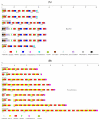Diversity of nonribosomal peptide synthetases involved in the biosynthesis of lipopeptide biosurfactants
- PMID: 21339982
- PMCID: PMC3039948
- DOI: 10.3390/ijms12010141
Diversity of nonribosomal peptide synthetases involved in the biosynthesis of lipopeptide biosurfactants
Abstract
Lipopeptide biosurfactants (LPBSs) consist of a hydrophobic fatty acid portion linked to a hydrophilic peptide chain in the molecule. With their complex and diverse structures, LPBSs exhibit various biological activities including surface activity as well as anti-cellular and anti-enzymatic activities. LPBSs are also involved in multi-cellular behaviors such as swarming motility and biofilm formation. Among the bacterial genera, Bacillus (Gram-positive) and Pseudomonas (Gram-negative) have received the most attention because they produce a wide range of effective LPBSs that are potentially useful for agricultural, chemical, food, and pharmaceutical industries. The biosynthetic mechanisms and gene regulation systems of LPBSs have been extensively analyzed over the last decade. LPBSs are generally synthesized in a ribosome-independent manner with megaenzymes called nonribosomal peptide synthetases (NRPSs). Production of active-form NRPSs requires not only transcriptional induction and translation but also post-translational modification and assemblage. The accumulated knowledge reveals the versatility and evolutionary lineage of the NRPSs system. This review provides an overview of the structural and functional diversity of LPBSs and their different biosynthetic mechanisms in Bacillus and Pseudomonas, including both typical and unique systems. Finally, successful genetic engineering of NRPSs for creating novel lipopeptides is also discussed.
Keywords: lipopeptide biosurfactants (LPBSs); nonribosomal peptide synthetases (NRPSs); nonribosomal peptides.
Figures




Similar articles
-
Genetic regulations of the biosynthesis of microbial surfactants: an overview.Biotechnol Genet Eng Rev. 2008;25:165-85. doi: 10.5661/bger-25-165. Biotechnol Genet Eng Rev. 2008. PMID: 21412355 Review.
-
Antifungal Lipopeptides Produced by Bacillus sp. FJAT-14262 Isolated from Rhizosphere Soil of the Medicinal Plant Anoectochilus roxburghii.Appl Biochem Biotechnol. 2017 May;182(1):155-167. doi: 10.1007/s12010-016-2317-z. Epub 2016 Nov 16. Appl Biochem Biotechnol. 2017. PMID: 27854037
-
PCR detection of novel non-ribosomal peptide synthetase genes in lipopeptide-producing Pseudomonas.Microb Ecol. 2011 Nov;62(4):941-7. doi: 10.1007/s00248-011-9885-9. Epub 2011 Jun 7. Microb Ecol. 2011. PMID: 21647696
-
Charting the Lipopeptidome of Nonpathogenic Pseudomonas.mSystems. 2023 Feb 23;8(1):e0098822. doi: 10.1128/msystems.00988-22. Epub 2023 Jan 31. mSystems. 2023. PMID: 36719227 Free PMC article.
-
Natural functions of lipopeptides from Bacillus and Pseudomonas: more than surfactants and antibiotics.FEMS Microbiol Rev. 2010 Nov;34(6):1037-62. doi: 10.1111/j.1574-6976.2010.00221.x. FEMS Microbiol Rev. 2010. PMID: 20412310 Review.
Cited by
-
Solid-phase synthesis of fusaricidin/LI-F class of cyclic lipopeptides: Guanidinylation of resin-bound peptidyl amines.Biopolymers. 2013 Apr;100(2):160-6. doi: 10.1002/bip.22186. Biopolymers. 2013. PMID: 23436339 Free PMC article.
-
Abiogenic Syntheses of Lipoamino Acids and Lipopeptides and their Prebiotic Significance.Orig Life Evol Biosph. 2015 Dec;45(4):427-37. doi: 10.1007/s11084-015-9451-4. Epub 2015 Aug 7. Orig Life Evol Biosph. 2015. PMID: 26248658
-
The Mode of Action of Bacillus Species against Fusarium graminearum, Tools for Investigation, and Future Prospects.Toxins (Basel). 2019 Oct 18;11(10):606. doi: 10.3390/toxins11100606. Toxins (Basel). 2019. PMID: 31635255 Free PMC article.
-
Visualization and characterization of Pseudomonas syringae pv. tomato DC3000 pellicles.Microb Biotechnol. 2019 Jul;12(4):688-702. doi: 10.1111/1751-7915.13385. Epub 2019 Mar 5. Microb Biotechnol. 2019. PMID: 30838765 Free PMC article.
-
Overexpression of specific proton motive force-dependent transporters facilitate the export of surfactin in Bacillus subtilis.J Ind Microbiol Biotechnol. 2015 Jan;42(1):93-103. doi: 10.1007/s10295-014-1527-z. Epub 2014 Nov 4. J Ind Microbiol Biotechnol. 2015. PMID: 25366377
References
-
- Georgiou G, Lin SC, Sharma MM. Surface-active compounds from microorganisms. Biotechnology (NY) 1992;10:60–65. - PubMed
-
- Arima K, Kakinuma A, Tamura G. Surfactin, a crystalline peptidelipid surfactant produced by Bacillus subtilis: isolation, characterization and its inhibition of fibrin clot formation. Biochem. Biophys. Res. Commun. 1968;31:488–494. - PubMed
-
- Nishikiori T, Naganawa H, Muraoka Y, Aoyagi T, Umezawa H. Plipastatins: new inhibitors of phospholipase A2, produced by Bacillus cereus BMG302-fF67. III. Structural elucidation of plipastatins. J. Antibiot (Tokyo) 1986;39:755–761. - PubMed
-
- Peypoux F, Pommier MT, Das BC, Besson F, Delcambe L, Michel G. Structures of bacillomycin D and bacillomycin L peptidolipid antibiotics from Bacillus subtilis. J. Antibiot (Tokyo) 1984;37:1600–1604. - PubMed
Publication types
MeSH terms
Substances
LinkOut - more resources
Full Text Sources
Other Literature Sources
Molecular Biology Databases

